Back Guide to visit Covadonga, the lakes and the surrounding area

Discover Covadonga, its Lakes and surroundings
Covadonga, the lakes and the surrounding area are one of those unique destinations. Here is a mini-guide with the must-sees in this area of Picos de Europa.
Cuadonga/Covadonga, the lakes and their surroundings are one of those places that you have to visit at least once in your life, and when you are there you will not want to leave, and of course you will come back.
In other words, it is one of those unforgettable, unrepeatable, unique places that leave an eternal impression on you. You come back and back, and you never tire of it. Every time is different.
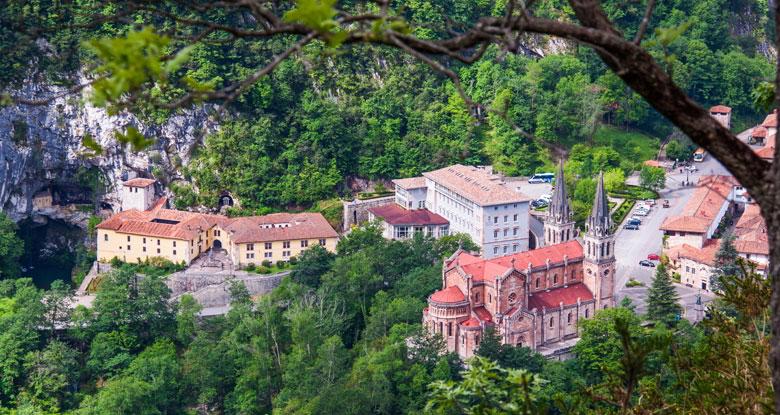
This area of eastern Asturias, located in the Picos de Europa National Park, is very well communicated. Cuadonga/Covadonga, just eight kilometres from the town of Cangas de Onís - the first capital of the ancient Kingdom of Asturias - could be your first stop.
Then, the ascent to the lakes will give you breathtaking views and landscapes, and if it is spring-summer, you will meet the Asturian mountain cow in its most beloved habitat, and if you look at the sky, numerous birds and perhaps a vulture will appear on the horizon?
As you can see, this little piece of paradise offers many possibilities. So with each visit, you'll be able to discover something new...
As for the services, no masses will be held in the Holy Cave of Covadonga in summer. It will remain a place of worship to visit the Santina.
On the other hand, in the Basilica, from Monday to Friday, several masses are celebrated daily, if you are interested you can consult the timetable.
So, to make the most of all the possibilities of this area, here you have a mini-guide to visit Cuadonga/Covadonga, the Lakes and its surroundings, where we will start with the must-see places.
What to see in Covadonga
The Holy Cave, a grotto full of magic and spirituality
Known as the "Cova Dominica" or Cave of the Lady, the Holy Cave is a special place, not only because it is a place of worship, pilgrimage and promise, but also because of the magic it radiates, and it is the first thing you come across when you arrive at Cuadonga/Covadonga.
Some ancient legends speak of a cave hermitage as early as the time of Pelayo, which gives an idea of the fascination that this place held for thousands of years for those who visited it.
The truth is that the monastic settlement in Cuadonga/Covadonga has been documented since the beginning of the 12th century, but be that as it may, we are dealing with a thousand-year-old devotion that has reached our days, and where the exuberant nature, the imposing mountains that surround Cuadonga/Covadonga, the leafy forests, or the imposing presence of water make up a space of infinite beauty and very propitious for peace of mind and spirit...
The cave where the Virgin of Covadonga is located is in the foothills of Mount Auseva, where the remains of the first king of the Asturian monarchy, D. Pelayo, and his son-in-law, King Alfonso I, also lie.
Just below the grotto, there is another cavity through which, in the rainy or thawing season, the famous stream of the river Mestas spills out, a spontaneous waterfall that falls into the "pozón".
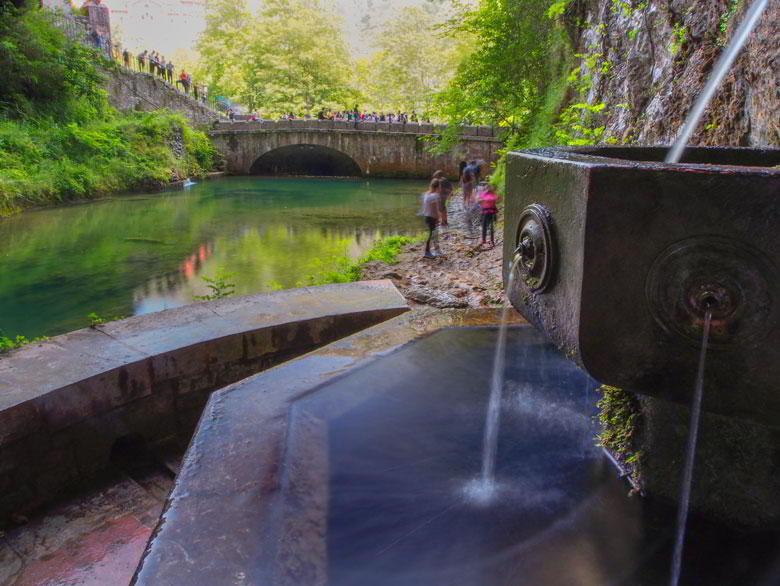
And the "pozón" is a pool of crystal clear water, surrounded by greenish vegetation, where you have to throw a coin to make a wish.
At the edge of the 'pozón' is the mythical Fountain of the Seven Spouts, to which popular literature attributes magical powers, claiming that "the Virgin of Covadonga has a very clear fountain. The girl who drinks from it gets married within a year".
And annexed to the Cave is the Renaissance Collegiate Church of San Fernando, built over the original monastery, excavated in the limestone of the Picos de Europa.
The Basilica of Covadonga, a "cathedral" in the middle of nature
The Basilica of Covadonga has been one of the spiritual and historical icons of the Royal Site for more than a century, gathering here thousands of travellers eager to enjoy and discover a unique space in the world.
This "Cathedral of Covadonga", as it was called for many years, was built on the Cueto hill, an elevation facing Mount Auseva, which offers privileged views of the Holy Cave and all its natural surroundings. Moreover, being on a steep cliff, it gives the sensation of caressing the sky with its towers, especially when you are arriving at the Royal Site, and you see it so high up.

It was Roberto Frassinelli, "the German from Corao", who inspired the design of the construction, in neo-Romanesque style, very much in keeping with the taste of the time, and also appropriate for the historical period it was intended to enhance.
King Alfonso XII laid the first holes to begin construction, and with the passing of time, this is a work of art and a site that is a must-see if you pass through Covadonga. It is worth taking a look at the paintings on both sides of the altar, at the choir stalls, at the organ, and to go down into the crypt, if it happens to be open.
In the vicinity of the Basilica esplanade, be sure to visit the old Hotel Favila, where the Museum of Covadonga is now located, and don't miss a visit to the Campanona, a unique piece, from which you also have spectacular views of the Basilica.
El Mirador de los Canónigos
The Cuadonga/Covadonga of yesteryear was a very peaceful place: a small village in the heart of the Picos de Europa, with an abbey, where the Abbot and the canons led an almost monastic life...
From that Cuadonga/Covadonga of pilgrims and promises, of spirituality and meditation, many sensations and corners remain, and one of them is the viewpoint of the Canons.
Just two kilometres from the Holy Cave, on the road that goes up to the Lakes, on the left hand side, you will find this place, where in the quiet afternoons in Cuadonga/Covadonga, the priestly community contemplated the Royal Site...
El Mirador de la Reina, for a happy sight
On the way to the lakes, about 8 kilometres from the Basilica, a stop not to be missed is the La Reina viewpoint - which has a car park - and from where you can enjoy marvellous views of the northern mountain ranges of the Picos de Europa, the meadows of the river Güeña and the Cantabrian coast.

Your retina will have a wide circular panoramic view with Picos de Onís, Cangas de Onís, Parres, Cabrales, reaching the coast in the area of Ribadesella and Llanes.
And without a doubt, the best times to enjoy the landscape are early in the morning or late in the afternoon.
The Lakes of Covadonga
The Lakes of Covadonga, a wonder of the world
The Covadonga Lakes, 12 kilometres from the Basilica, are a wonder of the world. Travellers from all over the world are captivated by its landscape and the atmosphere that its ecosystem provides.

And everyone, without exception, wants to repeat the experience of seeing themselves in front of the Ercina Lake, with the summit of Peña Santa de Enol projecting towards the sky, with its eternal snow-capped peaks. And meanwhile, the sound of the Asturian cows of the mountains, giving the most beautiful open-air concert you have ever heard...
Or that of standing in front of Lake Enol, with its meadow, its refuge, its chapel or its club, knowing that under its waters there is a replica of the Virgin of Covadonga, which divers bring to the surface every 8th of September.
The Lakes of Covadonga, admired by travellers, portrayed by artists, researched by scientists, the goal of sportsmen and women, are one of the most filmed places on the planet, especially as a result of being the end of the stage of the Tour of Spain.
A refuge for shepherds and inspiration for the creation of one of the best cheeses in the world, Gamonéu, the lakes are a reference point for hikers, mountaineers and seasoned travellers...
Mirador del Rey, the great vantage point overlooking the Pome beech forest
It is precisely at the end of the track that runs through the Vega de Enol, where you will find the Mirador del Rey, the great vantage point overlooking the beech forest or fayéu de Pome. The viewpoint also has the advantage of having interpretive panels.
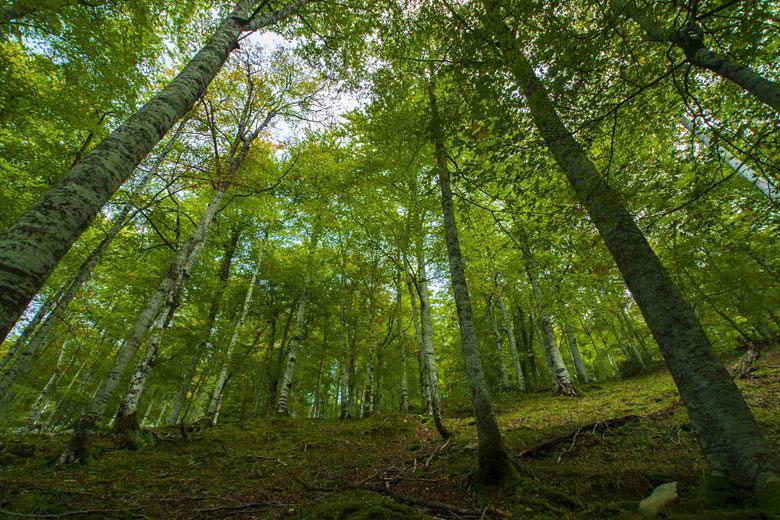
In Asturias, and of course, in the Picos de Europa, the beech forests are a spectacle of nature all year round: in spring, with their green shoots of pure life, and in autumn with the multiple shades of their foliage, which turn the forest into an infinite chromatic spiral.
That's why the view of the forest is always a blessing from heaven...
The Bricial, the third lake
And on this tour we are going to let you in on a secret: the Covadonga Lakes are not two, they are three...
Yes, that's right. There is a temporary lake called El Bricial, which you can reach by the shepherds' paths that leave from the meadows of La Ercina or Enol.
It will take you about an hour to get there, and the most comfortable path is the one that starts from the small chapel of Santiago in the Vega de Enol.
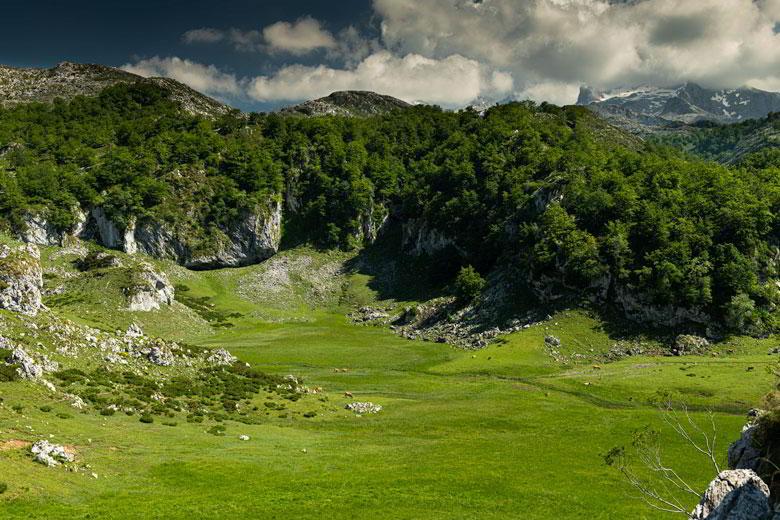
El Bricial is at the foot of the peak of the same name, and just opposite is the beech forest of Mount Palomberu, another wooded wonder of the Picos de Europa National Park.
The best time - if you are lucky - to see this curious "intermittent" lake is in spring, coinciding with the thaw. You will see that you can do a circular route, i.e. go via La Ercina and return via Enol, or vice versa.
The Entrelagos viewpoint, with unique views
This is the viewpoint on the hill that separates the Enol and Ercina lakes. Here there used to be a mountain hotel, and today there is a hut for use by the park's nursery.
Whether you go up from Lake Enol or from Lake Ercina, you can take a quiet and easy walk, and at the top you will have a unique view: in a panoramic sweep you will see both lakes at the same time, a perspective that you will not have from any other place in the Park.

Viewpoint of the Prince and the Vega de Comeya
The Príncipe viewpoint is another of those places with spectacular views that you cannot miss in the Picos de Europa. Located in the vicinity of the Buferrera area, in the western massif of the Picos, it offers a beautiful panoramic view of the Vega de Comeya.
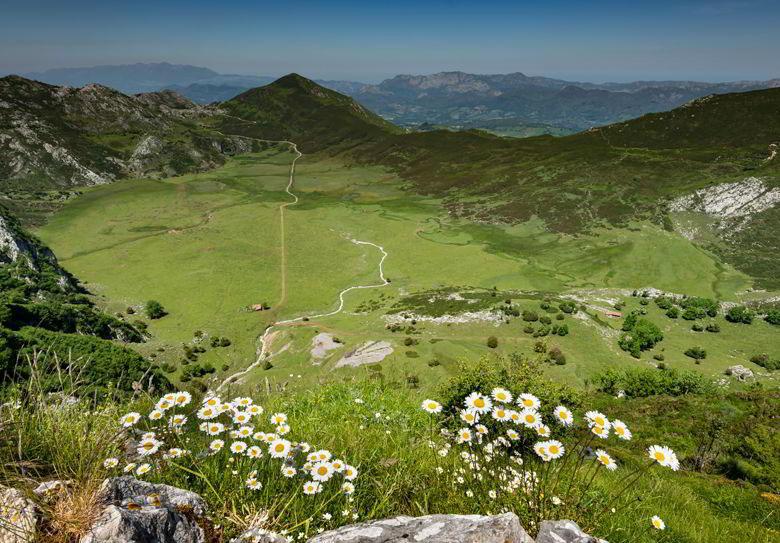
Comeya is today a large wet plain, also known as the absent lake of Cuadonga/Covadonga, because it was once a large lake, which with the passage of time, dried up, due to the porous conditions of the subsoil.
You will be impressed to walk around it. It is enormous, very green. A plain between mountains that still preserves the remains of old mining installations, and which gives you an idea of the living and changing universe of the Picos de Europa.
The mines of Buferrera, a history of mining in the Picos de Europa
There was mining in the area around the Covadonga Lakes, and although this activity ceased in the 1970s, traces remain that give an idea of the geological wealth of the area, and of the harshness of the extractive work that was carried out there for centuries.
A visit to the Buferrera mines, in the midst of a surprising landscape, is instructive and didactic, as well as entertaining. The area has been restored and refurbished so that you can visit the tunnels and mining installations.
And so, when you leave this underground world where minerals such as iron, manganese and mercury were extracted, you will find yourself in a green world, with peaks and limestone massifs as a backdrop, with lakes and springs, and cows with their herds of cows in the sheepfolds.
In short, the binomial mining and mountain in its maximum expression of beauty and authenticity.
El Mirador de la Princesa
Leonor de Borbón is the first princess in the history of Spain to have a dedication in Picos de Europa in the form of a viewpoint.
The Princess's Viewpoint, the latest to be inaugurated in Picos de Europa in September 2018 to commemorate the centenary of the National Park, is located on Sohornín peak, at an altitude of over 1,000 metres, with Lake Enol at its feet and a panoramic view of the great peaks of the western massif of the Picos de Europa.
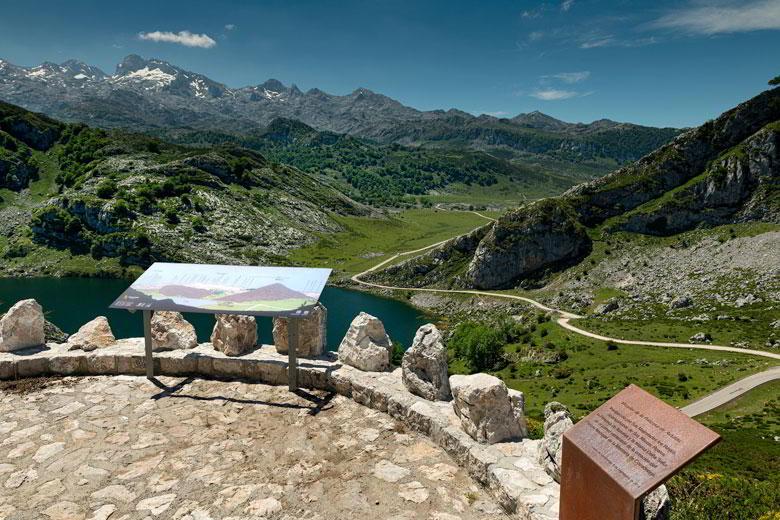
It is also the fourth viewpoint dedicated to Spanish royalty in the Asturian part of the Picos de Europa.
Here history and nature go hand in hand, united by splendid views.
Precisely the views you can contemplate from this viewpoint are those shown in the cover photo of this post.
The Pedro Pidal Interpretation Centre, ideal for understanding this space.
The Centre bears the name of the driving force behind the National Parks Act of 1916, who was responsible for the first park being the Montaña de Covadonga in 1918, the predecessor of the Picos de Europa National Park.
In the reception area of the centre there is a space dedicated to the life and history of Pedro Pidal, Marquis of Villaviciosa, a multifaceted and adventurous character, a great connoisseur of these mountains and ahead of his time.
The centre is divided into seven sections: Reception, Pedro Pidal, The Picos de Europa, Man in the Picos de Europa, Audiovisual Room, The National Parks Network, and the Bookshop-Shop.
In fact, it tries to offer a summary of the natural and human ecosystem of the Picos, with an evolutionary and historical perspective.
There is also an arboretum outside with native species, and the whole complex is very close to the Buferrera Mining Museum.
Practical information
Routes
The Picos de Europa National Park and its surroundings offer you a multitude of options for your free time.
It will be more than obvious to you that you are in a true hiking paradise, with such emblematic routes as the Frassinelli route (PR-PNPE. 1), which runs from the Buferrera car park to Corao, passing through Vega de Comeya, Cañavalles, Tarañodios, Uporquera, El Pandal and Abamia.
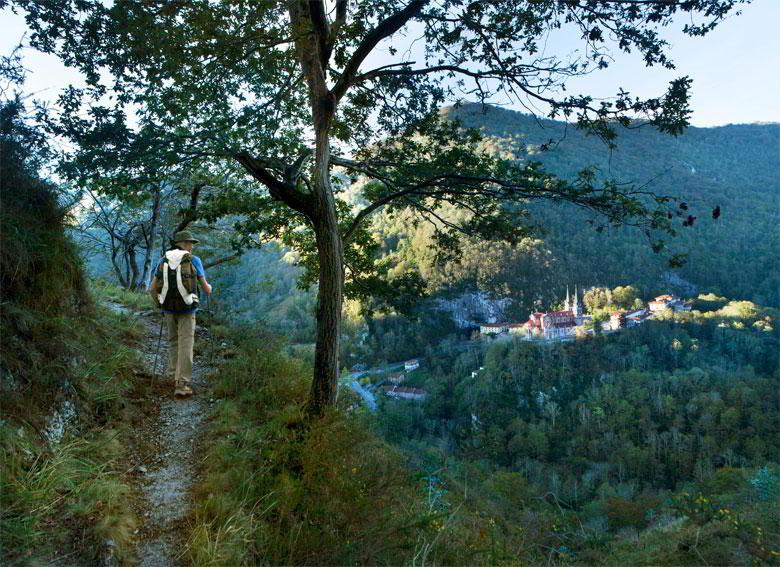
Or the Los Lagos route (PR-PNPE. 2), which also starts at the Buferrera car park and returns to this place, passing through the Pedro Pidal Visitor Centre, the Principe Viewpoint, the Buferrera Mine, Lake Ercina, the Bricial, the Palomberu Beech Forest, the Vega de Enol and Lake Enol.
So it is very rewarding to enjoy nature in this environment, and if you decide to do it with a professional guide, the experience will be extraordinary.
Visits to cheese dairies
But you can also visit cheese dairies to find out in situ how cheeses as characteristic of the area as Cabrales or Gamonéu are made and how they taste. These cheeses can be tasted in any of the restaurants in the area, or purchased directly in gastronomic shops or in the cheese dairies themselves, some of which are open to visitors.
Active tourism activities
And if rivers are your thing, you can do a tourist descent of a historic river like the Sella. It's a simple activity, very suitable for families or friends, and you can also take your pets with you.
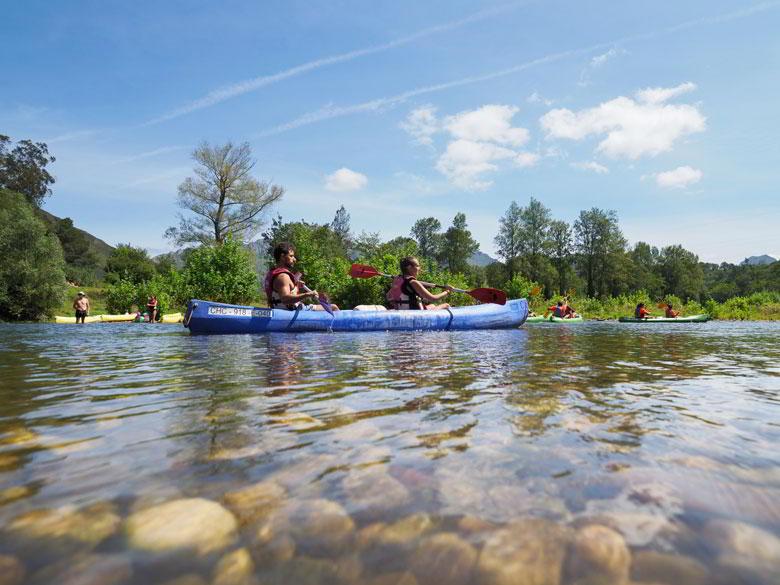
Canyoning, climbing, horse riding, buggy or quad routes, etc. are other possible options.
In short, there are endless possibilities within your reach, in a 100% natural environment, where tranquillity is an identifying value of the area.
How to get to Cuadonga/Covadonga
To make the most of this destination, it is important to find out how to get there. In order to protect the Picos de Europa National Park (Biosphere Reserve), an Access Plan to the Covadonga Lakes has been designed for public transport only. This plan regulates access during the peak days of Easter, summer and long weekends.
The rest of the year, private vehicles may be used freely. The section of road that is closed is the one that goes from Cuadonga/Covadonga to the Lakes.
During the regulated periods, a fleet of buses will guarantee your journey between Cangas de Onís, Cuadonga/Covadonga and the lakes, making stops at the main points of interest along the route.
It is also advisable to buy tickets in advance, https://www.buslagoscovadonga.esSe opens in a new tab.
Where to stay in the area
Of course the whole area offers you comfortable and cosy accommodation to immerse yourself in the nature and atmosphere of this part of the Natural Paradise.
Here you have information about where to sleep in the area, and also just a click away you can make your Online Reservation.
Recommendations
What you should know...
- It is forbidden to fish or bathe in the lakes.
- It is a Biosphere Reserve and in order not to damage the ecosystem it is advisable not to leave the paths. Do not make turrets with the stones in the lake either, so as not to alter the ecosystem.
- It is a public place that many people use to disconnect. Try to speak quietly so as not to disturb.
- The animals are free in their natural habitat, do not disturb them or feed them.
- If you take your pet with you, you must keep it under control. Pets must be kept on a leash.
- Don't forget to pick up your litter.
- Do not litter.
- The weather sometimes changes quickly. For this reason it is advisable to take warm clothes, even in summer, and of course a mackintosh.
- If you are going hiking, don't forget to bring water and food.
- And very important: always let us know which route you are going to do, in case of any incident, so that you can be located. Mobile phone coverage is not always available.
- If you have any problems, don't forget to call 112.
- Before going up to the lakes, find out what the weather is like.
- If you are in your vehicle, always drive with caution. Fog or ice may appear, and they are always risk factors.
- Always remember that you are in the high mountains, and that the best ally for maximum enjoyment is prudence.
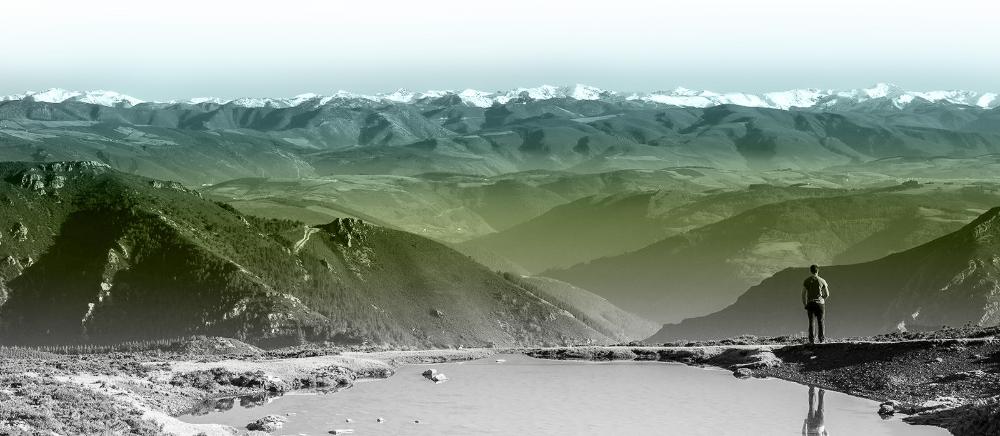
Subscribe to our newsletter and take advantage of offers, discounts, and news
Subscribe



